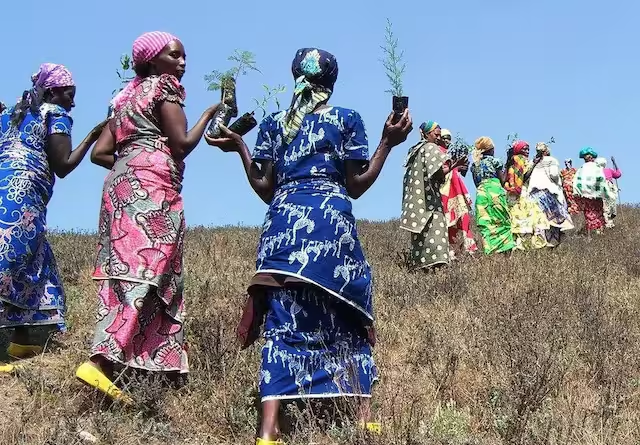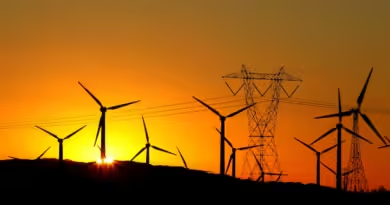Comment: Dear COP29, it’s time to put women-led climate solutions on the agenda
April 18 – Last year, Dubai’s COP28, or U.N. Climate Change Conference of the Parties, was hailed by many as the “fossil fuel COP”, as it established a global agreement to “transition away from fossil fuels” while having a record number of fossil fuel lobbyists, opens new tab in attendance. The event also marked the first time the conference dedicated an entire day to activities underscoring the links between climate change and human health.
In the spirit of there being a first time for everything and COP29 being touted as the “finance COP”, now is the ideal time for COP29 organizers to include financing women-led climate initiatives on the upcoming summit’s agenda. It was Zainab Salbi, co-founder of Daughters for Earth, which funds climate solutions driven by women and girls around the world, who shared with me that this hasn’t been done yet at COP.
Perhaps this year is the window. After all, the current COP organizing team members are no strangers to hearing commentary about the need to include women in the climate conversation. The originally assigned COP29 committee was all-male until President Ilham Aliyev of Azerbaijan changed it to 29 men and 12 women, following a steady flow of backlash. As Elise Buckle, co-founder of SHE Changes Climate, stated in January, opens new tab: “This is a quick fix but not enough.”
It’s way past time to make gender equity an integral part of global climate policy and investing. This isn’t about PR, CSR, or even ESG. This is about basic common sense. Women are more likely to be affected by the impacts of climate change than men, meaning they are more likely to see and feel it coming, learn how to adapt, and care for others during extreme weather and natural disasters.
Contrary to what exorbitantly funded fossil fuel campaigns would have the mass public believe, sucking carbon from the air and urging individuals to be more conscious of their carbon footprint isn’t enough. On-the-ground solutions need more amplification and support, and many of these projects are being spearheaded by women.
So what is it going to take for governments and institutions to replace reactive gender parity lip-service with meaningful action?
From my perspective, pulling data about the benefits of ensuring women have adequate access to climate finance isn’t shifting the paradigm. But for posterity’s sake, I’m going to right now.
Plain and simple: while climate change affects women disproportionately, Indigenous women, Black women, women from low-income communities and the Global South face an even heavier toll, due to the continuous impacts of colonialism and inequality. At the local level, the participation of women in natural resource management is associated with better resource governance and conservation outcomes.
According to research for the World Bank, opens new tab, women leaders take more corporate action to confront climate change. Women are also more likely to build successful organizations that address social needs, and produce a higher return on investment.
Unfortunately, investments in women working in climate are scant. Although funders channeled more than $600 billion into climate-related investments in 2021, according to ImpactAlpha, investments intended to address gender inequalities or that specifically supported women-led solutions received less than $20 billion. Adding salt to the wound, only 0.01% of global finance supports gender-responsive initiatives.
While the above numbers are dismal, they needn’t be the end of the story. The private sector can take action. As companies revisit their climate pledges and strategies, they can incorporate funding women-led climate projects directly.
One of the top issues I hear from corporations struggling to meet their climate goals is that their chief financial officers are apprehensive about putting money toward climate projects because they don’t understand how they work. If that’s the case, removing the middleman and going directly to the women-led solutions is a great place so start. There’s no shortage of these, and many of them are nature-based.
Just look at some of the projects supported by Daughters for Earth, such as Re:wild Your Campus, opens new tab, which advocates for the elimination of herbicides and a transition to organic land care across U.S. college campuses. Founded by Hawaii native Mackenzie Feldman, the group has worked with 40 college campuses so far.
Meanwhile in Guatemala, the Maya people uphold a treasure trove of traditions dating back thousands of years that are symbiotic and respectful to biodiversity and agriculture. The Mayan Wisdom Project, opens new tab, co-founded by Solveig Barrios, works directly with older farmers and small indigenous, family-owned businesses to support the local economy and to bring regenerative practices to the modern world.
In Uganda, the group TreeSisters, opens new tab is providing agroforestry training in Uganda for women to support climate resilience. With a grassroots network of 250,000 women around the world, TreeSisters is planting almost two million trees across Kenya, Brazil, Madagascar, India, Nepal and Cameroon.
Another collaborative, women-led, international climate initiative is the Women’s Earth and Climate Action Network (WECAN). Aiming to “re-frame and redirect the narrative on climate change” to ensure that women’s work in the fields, forests, streets universities, and halls of power is pushed to the forefront of the climate discussion, the groups works closely with Gulf South Indigenous women, fostering local food networks that protect cultural practices.
Corporations seeking to support a just and sustainable climate transition can design strategies to ensure equal participation from all genders in climate-related programs. This can include stakeholders and local communities.
Companies can also take proactive measures to recruit women in climate-related leadership roles. And of course, male counterparts can make it a point to be publicly vocal about supporting women working in climate. This includes science, biodiversity, conservation, grassroots activism, environmental justice, environmental studies, carbon removal, climate tech, renewable energy, energy efficiency, EV, and women-led, community-driven solutions around the world.
The climate movement needs the private sector to push for the financing of women-led solutions to be on the official COP agenda. Intrinsically, in order for companies to execute sustainable climate strategies women need to be equally represented and funded – from corporate leadership roles to frontline community projects. It’s basic math. It’s the right thing to do. And it’s one of the most glaring and problematic oversights of our time. But as I mentioned earlier, COP is not foreign to the concept of there being a first time for everything.




